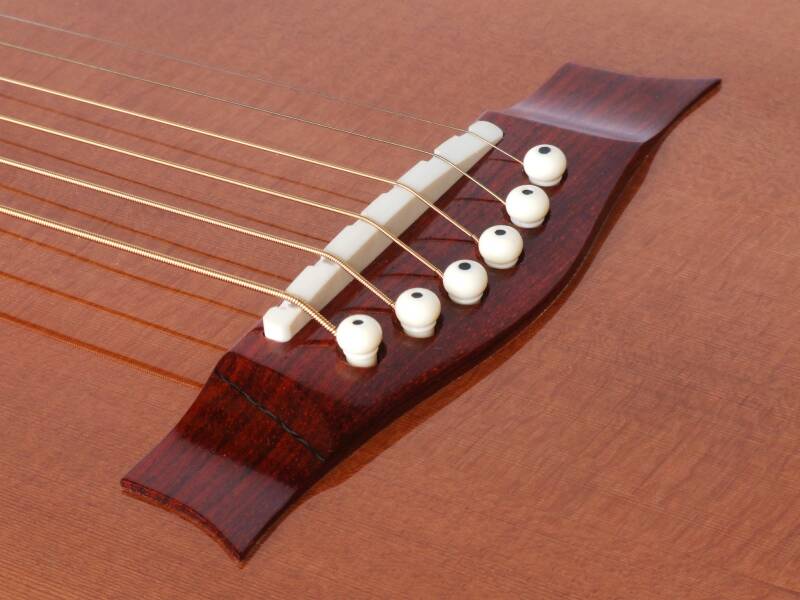Quote:
|
Why is a bridge as thick as it is generally accepted to be ?
|
Because that's how it's generally accepted to be. That doesn't make it right (or wrong). If you have the engineering chops, you can make it pretty much what you like. For example, keeping a fairly traditional bridge shape and footprint area, you can take the back side of the bridge down to something like this:

Depending what you choose for materials (the one above is Bloodwood) you can make very low mass bridges. For example, a bridge like the above made of American black walnut will weigh about 14 grams. That's pretty light for a bridge, where some people consider 60 grams to be in the normal range. BTW, that dark line you see in the bridge wing is carbon fibre.
And, of course, it changes the sound of the guitar. First up, a low mass bridge is easier to accelerate under the meager vibration forces produced by the strings, and as sound radiation is proportional to the acceleration of the guitar top, the guitar gets louder. It can also get brighter and maybe somewhat raucous, (think flamenco) which is fine if that's what you (or your customer) wants, but it is a long way from sounding like a banjo (which works on different principles). Having made guitars with some very low mass bridges and some with more normal mass bridges, I would say that it is pretty hard to make a bridge too light whilst still maintaining fairly traditional outline shapes, materials and foot print area. Much easier to make it too heavy.
With regard to the stresses on the glue line, traditional simple analysis (rigid body diagrams etc.) whilst very useful in engineering in general, doesn't serve us well here, because the bodies under consideration are too far from being rigid for the usual assumptions to apply. The actual forces are very dependent on the local physical geometry and the variation in flexural rigidity as one transitions the bridge/top/bridge plate sandwich, to the top and bridge plate to just the top. At a section change (say bridge+top to just bridge) there is always a stress concentration and in a normal bridge failure mode (a peel failure from the back edge) it is the degree of that stress concentration that determines whether or not the glue line fails. The stress concentration can be seen on this finite element analysis of the bridge/top interface that was done by the late
David Malicky (who also originated some of the other diagrams posted in this thread):

We can see in this diagram that the stress concentration factor is 10 or more at the back side of the bridge and is exacerbated by thick back edge of the bridge. By tapering the back edge of the bridge and by suitable design of the bridge plate that stress concentration factor can be reduced considerably, to the extent that the actual local stress on a well designed steel string bridge can be less than found on a typical classical guitar bridge where there is a large step-down from the tie block to a thinner, more flexible top, often with no bridge plate.
Quote:
|
The material used to anchor the pins or support the string ends becomes purposeless mass . Because of this the bridge can be trimmed to eliminate this now unnecessary mass or am I wrong about this ?
|
If you slot the bridge pin holes, you should be able to remove the bridge pins with no ill effect. Therefore not only is the mass at the back of the bridge "purposeless", so are the pins.
So you're not wrong, but you do need to understand what's going on to guide your design decisions.